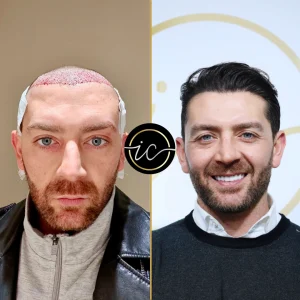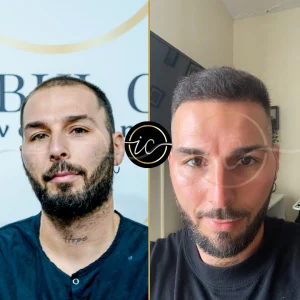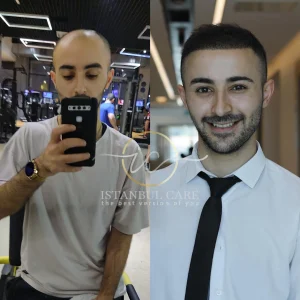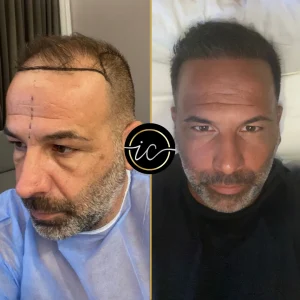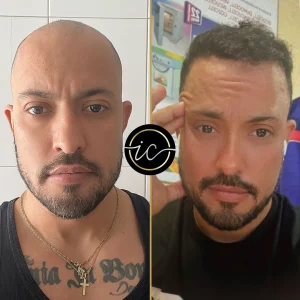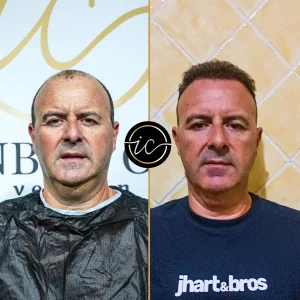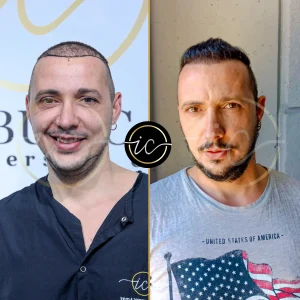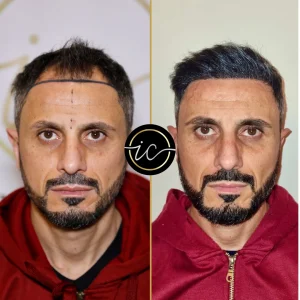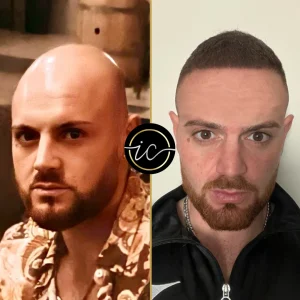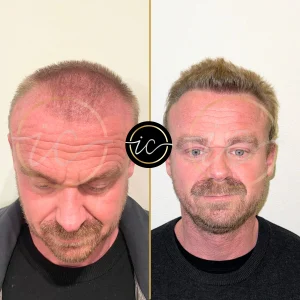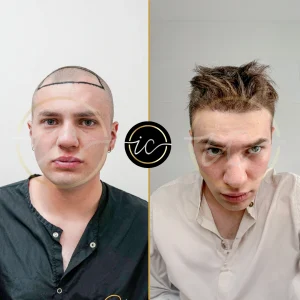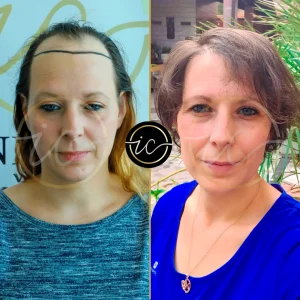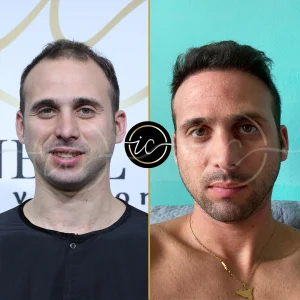Hair transplant at Istanbul Care has positioned the country as a global leader, thanks to its advanced medical technologies, experienced specialists, and competitive pricing. Offering reliable and effective solutions for hair loss, Turkey continues to attract individuals from around the world seeking high-quality care.
| Technique | Operation Time | Recovery Time | Price (Turkey) |
|---|---|---|---|
| FUE | 2 – 4 hours | 2 – 3 weeks | $1,290 – $1.490 |
| FUT | 4 – 12 hours | 2 – 3 weeks | $1,290 – $1.490 |
| DHI | 8 hours | 2 – 3 weeks | $1,290 – $1.490 |
| FUSS | 2 – 5 hours | 2 – 3 weeks | $1,290 – $1.490 |
| Sapphire FUE | 4 – 6 hours | 2 – 3 weeks | $1,290 – $1.490 |
What is Hair Transplant Turkey?
Hair transplant Turkey is a hair transplantation process in Turkey, and in this process, hair follicles taken from the donor area are transplanted to the balding areas. In this way, the problem of baldness is solved.
Patients from all over the globe go to Turkey to have this procedure done. Most hair transplant turkey clinics usually offer all-inclusive packages that include surgery, accommodation and transportation, making it even easier for patients from other countries.
Expert Turkish surgeons employ cutting-edge methods like Follicular Unit Extraction (FUE) and Follicular Unit Transplantation (FUT) to provide patients with natural-looking hair restoration.
For those seeking surgical solutions to hair loss, hair transplant Turkey is a popular alternative because to its affordable rates and strong healthcare standards. Another common practice is to mix medical tourism with vacationing, allowing patients to fully immerse themselves in the host country’s history, culture, and natural beauty while they get well.
How is Hair Transplant Turkey Done?
The hair transplant Turkey is done utilizing cutting-edge methods that guarantee painless, natural-looking outcomes.
The surgeon will choose the best technich for hair transplant Turkey and best course of action after evaluating the patient’s health, the donor location, and the pattern of hair loss during the first consultation.
Direct Hair Implantation (DHI) and Follicular Unit Extraction (FUE) are the two most used methods. Follicular unit extraction (FUE) is a technique that uses a specialized instrument to remove individual hair follicles from a donor location, which is usually the back of the head.
After that, the balding or thinning spots are meticulously implanted with these follicles. Follicle implants performed utilizing the DHI technique are more accurately placed and heal more quickly since they are placed directly into the scalp using a Choi pen. Because local anesthetic is often used, the process is almost painless.
In order to promote the best possible recovery and hair development following surgery, patients get comprehensive aftercare instructions. In most cases, the whole procedure just takes one day, and then, after a few months, you’ll see new hair grow in, giving your hair a thicker, more natural look.
Hair Transplant Cost Comparison
| Location | Cost | Savings USA | Savings Europe |
|---|---|---|---|
| USA | $10,000 | — | — |
| Europe | $8,000 | $2,000 | — |
| Turkey (General) | €3,000 | $7,000 | €5,000 |
| Istanbul Care | €1,490 | $8,510 | €6,510 |
If you choose Turkey, you save up to $7,000 compared to the USA and €5,000 compared to Europe.
Choosing Istanbul Care offers even greater savings: up to $8,510 compared to the USA, and €6,510 compared to Europe. Plus, you’ll save €1,510 even compared to general Turkey prices!
Advantages of Hair Transplant Turkey
The advantages of getting a hair transplant Turkey are numerous, making the country a top choice for individuals seeking effective hair restoration.
Among the main advantages is the top-notch treatment offered by skilled surgeons who are experts in cutting-edge hair transplant Turkey methods like Direct Hair Implantation (DHI) and Follicular Unit Extraction (FUE). Modern technology in Turkish clinics guarantees accuracy and flawless, lifelike outcomes.
On top of that, compared to other nations, hair transplant Turkey offers a much more affordable price without sacrificing quality. Because of its low prices and all-inclusive packages that include the surgery, hotel, and transportation, Turkey is becoming more and more popular among foreign patients.
In addition, Turkish clinics have a stellar reputation for patient care, thanks to their bilingual personnel and the individual attention they provide each patient. Hair transplant Turkey is an excellent option for those looking to restore their hair because of the combination of professional skill, cutting-edge technology, reasonable cost, and thorough care.
Hair Transplant Cost Comparison: Turkey vs. Europe and the USA
Hair transplant procedures in Turkey are significantly more affordable compared to Europe and the USA, making it a top destination for medical tourism. While the average cost of a hair transplant in the USA or Europe ranges between $7,000 and $15,000, the same procedure in Turkey costs around $2,000 to $4,000 without compromising on quality.
Moreover, at Istanbul Care Hair Transplant Clinic, prices start from as low as $1,290, offering exceptional value with top-tier results. Turkish clinics are equipped with cutting-edge technology and highly experienced surgeons, ensuring outcomes that meet international standards. This cost advantage, combined with world-class care and comprehensive treatment packages, makes Turkey a preferred choice for those seeking effective and budget-friendly hair restoration.
Best Hair Transplant Techniques
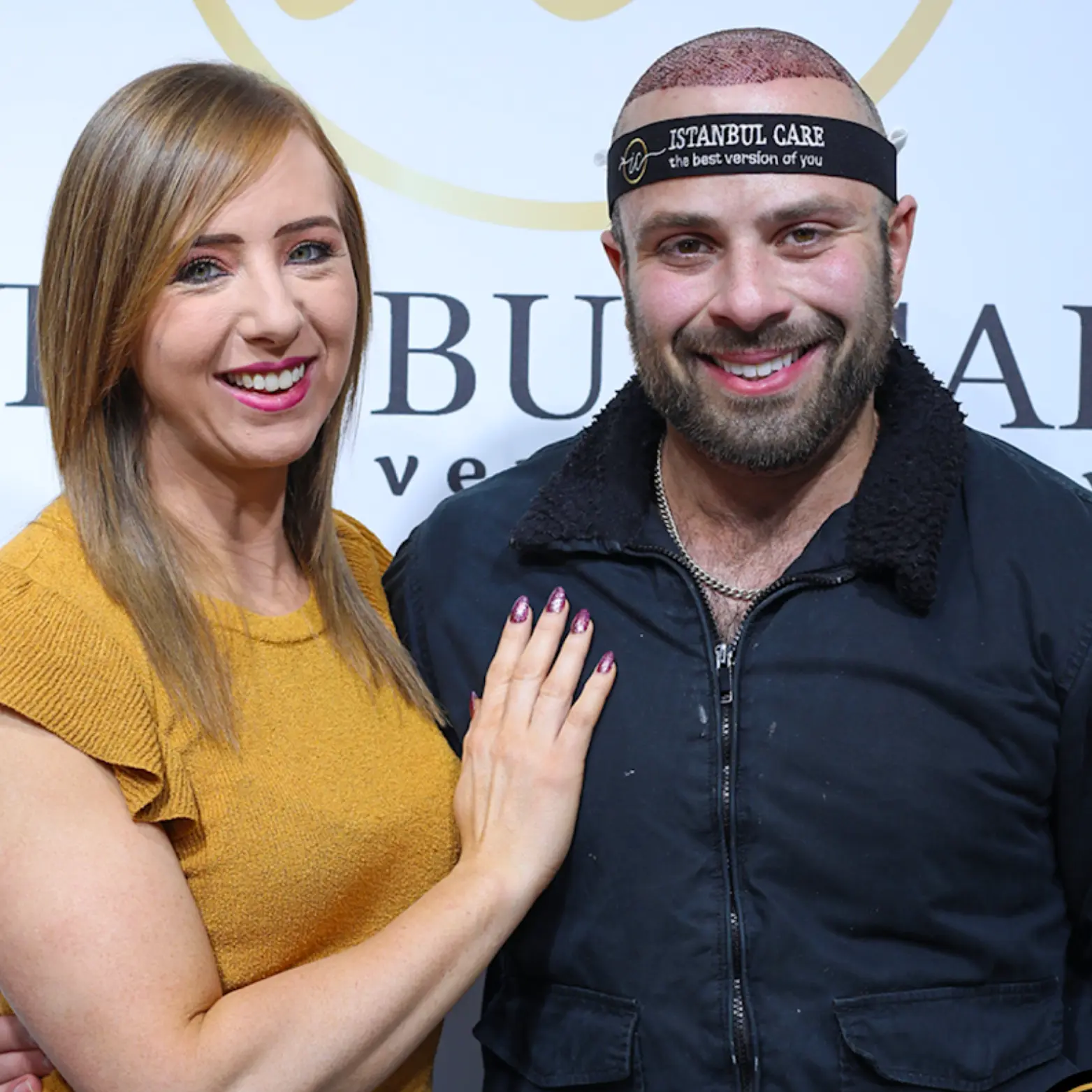
A number of high-quality methods have been developed for the purpose of regrowing damaged hair. Every approach has its own set of advantages that make it suitable for various situations and tastes:
- FUE Hair Transplant: The low level of invasiveness associated with Follicular Unit Extraction (FUE) makes it a popular choice. Hair follicles are extracted one by one from the donor site, which is often the back of the head, by use of a tiny punch instrument. The bald spots are subsequently filled with these follicles one by one. For those who like short hairstyles or would prefer not to have visible scars after surgery, FUE is a great option since it has a quicker recovery period and does not leave any linear scars.
- FUT Hair Transplant: Strip surgery is another name for this technique, which entails removing a thin layer of skin from the donor site and then separating and transplanting individual hair follicles. The lower cost of FUT makes it the preferred method over FUE for patients who need a high volume of grafts in a single session. A linear scar will appear, although it will be easy to hide with longer hair.
- DHI Hair Transplant: The Choi Pen is a specialized instrument that is used in Direct Hair Implantation (DHI), a variation of the FUE method, to simultaneously extract and implant hair follicles. This technique produces a hairline that looks completely natural by giving the surgeon more control over the placement of each implanted hair. In comparison to conventional FUE, DHI usually results in less scarring and a shorter recovery period.
Robotic Hair Transplant: Hair follicle extraction (FUE) is automated using robotic technology in robotic hair transplantation, which improves accuracy and speed. Transplanted hairs have a better chance of life thanks to the robotic system, which decreases the likelihood of human mistake. It helps keep the donor area looking natural, which is a major plus.
How Long Does Hair Transplantation Take?
Several variables, such as the method used, the degree of hair loss, and the quantity of grafts being transplanted, may significantly affect how long a hair transplant process takes. The following is often what people may anticipate:
There is typically a consultation and a period of pre-operative preparation before the actual operation. As part of this process, your doctor may ask you questions about your health history, assess the extent of your hair loss, and help you map out your hairline or target regions. This part of the process could take a few hours or be planned many days in advance of the operation.
Process Duration:
FUE: Depending on the amount of grafts required, a Follicular Unit Extraction (FUE) process might take anywhere from four to eight hours. Splitting the process over two consecutive days is sometimes necessary when the number of grafts is very great.
FUT: FUT typically takes anywhere from 4 to 7 hours, which is comparable to FUE. If a large region has to be covered, it can be the way to go since it usually enables for multiple grafts to be transplanted in one session.
DHI: Because the implantation technique is more accurate and done concurrently with extraction, DHI (Direct Hair Implantation) operations could take somewhat longer than FUE. The amount of grafts involved determines how long a session may go, which might be eight hours or more.
There will be a short window for post-operative instructions and care right after surgery. Approximate time required: one hour. In order to speed up the healing process, many surgeons advise patients to rest lightly for a few days after scalp surgery.
In order to make sure the transplant went well and that the patient is mending properly, there may be follow-up visits. These checkups are essential for evaluating the health of the newly grown hair and determining if more treatments are necessary.
All-Inclusive FUE Hair Transplant Turkey Package
- Operation with FUE Sapphire technique (by the Doctor)
- 2 Plasma/PRP injection
- Blood test (before surgery)
- Medications after surgery (stomach protector, painkillers, anti-swelling, antibiotics, cream)
- Special shampoo and lotion (special formula from the Istanbul Care laboratory)
- Medical neck pillow
- Medical check-up (after transplant)
- Hair washing (by our doctor after the operation)
- Lunch on the day of the operation
Accommodation: Hotel 2 nights (breakfast included)
VIP transport: Airport-Hospital-Hotel
Guarantee Certificate
Personal translator
Follow-up and support for 1 year
1 companion included
News: RED LIGHT THERAPY
News: TREATMENT WITH STEM CELLS
All-Inclusive Hair Transplant Turkey Package
- Operation with Direct Hair Implantation technique (by the Doctor)
- 2 Plasma/PRP injection
- Blood test (before surgery)
- Medications after surgery (stomach protector, painkillers, anti-swelling, antibiotics, cream)
- Special shampoo and lotion (special formula from the Istanbul Care laboratory)
- Medical neck pillow
- Medical check-up (after transplant)
- Hair washing (by our doctor after the operation)
- Lunch on the day of the operation
Accommodation: Hotel 2 nights (breakfast included)
VIP transport: Airport-Hospital-Hotel
Guarantee Certificate
Personal translator
Follow-up and support for 1 year
1 companion included
News: RED LIGHT THERAPY
News: TREATMENT WITH STEM CELLS

Speak with our expert Hair Transplant specialists
We’re ready to answer your questions
Is Hair Transplant Surgery Painful?
Although most people do not see hair transplant surgery as unpleasant, it is possible to experience some discomfort throughout the treatment, as is the case with any medical operation. First, the areas to be numbed for the hair extraction and implant procedures will be administered with local anesthetic. So, you shouldn’t expect much, if any, discomfort while the process is underway.
Having said that, everyone’s perception of pain is unique. The anesthetic usually takes care of any little pain or pressure that patients may experience throughout the extraction and implantation processes.
As the anesthetic wears off, you may feel some discomfort, soreness, or slight pain in the regions that were treated after the surgery. In order to alleviate any pain that may occur after surgery, our clinic will give pain medication. As the body heals after surgery, you may see some redness and swelling in the days after the procedure.
It’s important to mention that whereas previous methods like Follicular Unit Transplantation (FUT) required stripping the scalp, which might leave a larger incision, more recent procedures like Follicular Unit Extraction (FUE) often result in less painful recovery.
Is It Safe To Get Hair Transplant Turkey?
Assuming you go with a respectable facility and an experienced surgeon, getting a hair transplant Turkey is usually a safe bet. Attracting patients with its mix of qualified professionals, cutting-edge technology, and affordable prices, Turkey has become a worldwide center for hair implantation. Selecting a reliable clinic and surgeon are crucial to ensuring a safe and successful operation.
It’s critical to choose a facility that uses cutting-edge technology and follows global health regulations. Verify the surgeon’s credentials and patient results are open and honest, and make sure they have a solid track record. The operation is much more secure at respectable clinics in Turkey because of their meticulous cleanliness standards and all-encompassing patient care. To guarantee a safe and effective hair implant, it is important to do comprehensive research and read patient testimonials to get insight into the level of care offered.
How Long After a Hair Transplant Can I Wear a Hat?
Wearing a cap after a hair transplant takes some time to allow the new grafts to heal and grow properly. The standard recommendation from surgeons is to wait at least 7 to 10 days before donning a hat. It is essential for the transplant to wait for the freshly transplanted hair follicles to firmly attach themselves to the scalp.
During the first week after surgery, the scalp may be very sensitive; wearing a helmet, for example, might put too much pressure on the area, which could cause the skin to itch or even dislodge the transplants. You may gradually go back to wearing loose-fitting headgear, such sun hats or baseball caps, after the first seven or ten days, as long as they don’t press on the region of the transplant. You should still hold off on wearing tight-fitting caps or any kind of headwear that can create friction for a while longer.
Talk to our surgeon before, during, and after the surgery if you have any concerns about the need to wear a hat, whether it’s for sun protection or any other reason. If the hat is really plush or has a unique design that keeps it from touching the grafts, they may approve of its use sooner rather than later. For the best possible healing and hair transplant outcome, it is imperative that you adhere strictly to our surgeon’s detailed instructions.
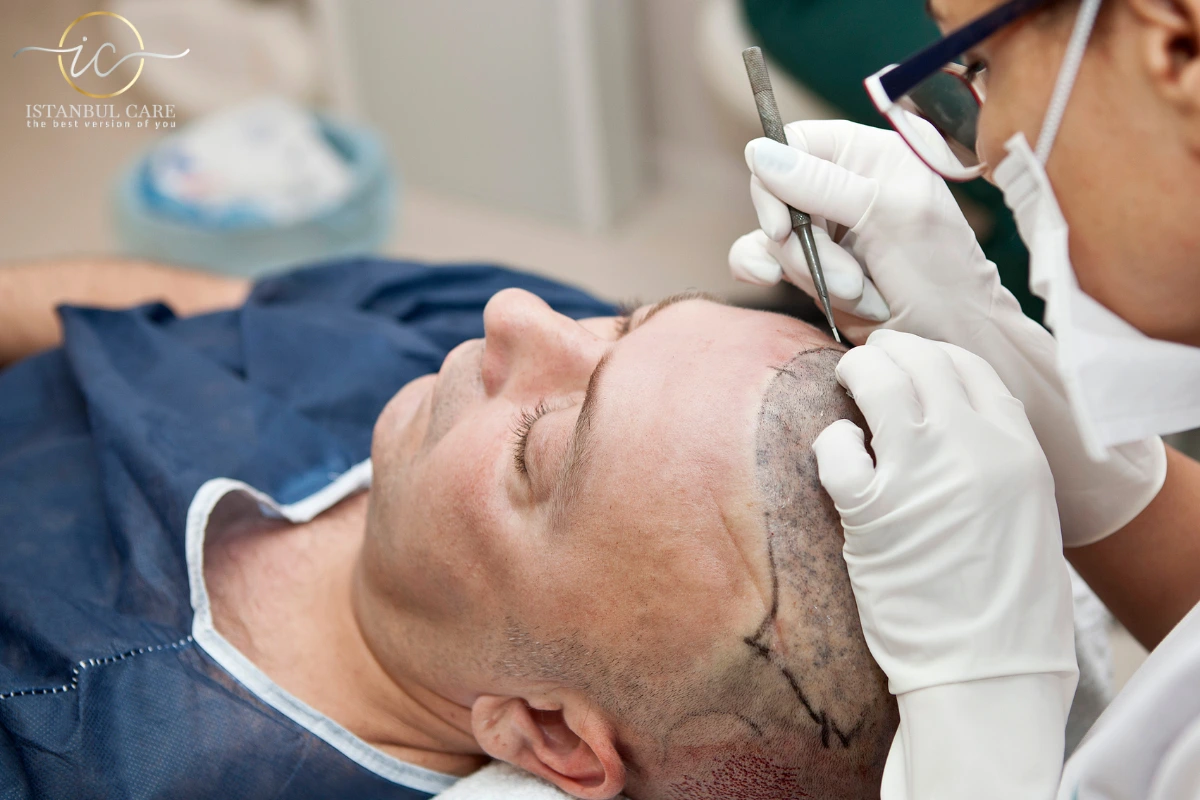
Can You Go Bald Again After a Hair Transplant?
The answer is yes, further hair loss may occur after a hair transplant. The process of a hair transplant involves transferring hair follicles from a healthy region of the scalp to an area that is experiencing thinning or balding. This often occurs at the back of the head or another place that is resistant to balding. The natural hair in the region where the follicles were relocated may still gradually shrink and fall out, even though the transplanted hairs are usually more resistant to the hair-loss hormone DHT.
This might cause a patchwork look because even if the transplanted hair stays, the surrounding natural hair could keep thinning. Particularly if the non-transplanted hair is still affected by the underlying cause of hair loss, which might be hormone imbalances or heredity, this becomes even more evident.
A Turkey hair transplant package will often include pre- and post-operative medical testing, as well as the actual hair treatment. Airport transfers, hotel stays, and interpretation services are just a few of the supporting services that patients may anticipate. Medications and post-operative follow-up appointments are also often included in packages to help patients recover faster and have better results. Turkey is a great choice for anyone looking for affordable and effective hair transplant options because of its comprehensive approach.
Which Hair Transplant is Best In Turkey?
Patients and specialists alike often cite the FUE (Follicular Unit Extraction) technique as the hair transplant Turkey best alternative available in Turkey. Turkey’s cutting-edge medical facilities, very talented surgeons, and affordable prices have earned country an outstanding reputation for hair transplant Turkey. Because it is less invasive than other procedures, leaves no linear scars, and assures a faster recovery period, the FUE technique is very well-liked.
To obtain natural-looking results, Istanbul clinics, including the well-known Istanbul-Care (best hair transplant of Turkey) Clinic, use cutting-edge technology and individualized treatment. With this technique, individual hair follicles from the donor region are removed and then implanted into the balding or thinning areas, enabling exact density control and placement. A natural hairline restoration, little pain, and a high success rate are what patients may anticipate.
Turkey is one of the top destinations for those looking for high-quality hair transplant treatments because of the country’s alluring tourist attractions and skilled medical care.

Turkey Hair Transplant Package
An initial consultation and examination are standard components of a full-service Turkey hair transplant package. During this appointment, your hair loss will be thoroughly evaluated and a treatment plan will be developed according to your unique requirements. Methods like FUE, DHI, and Sapphire FUE are part of this process. Surgeons with extensive training and expertise carry out the treatment utilizing cutting-edge methods to guarantee an undetectable scar.
A Turkey hair transplant package will often include pre- and post-operative medical testing, as well as the actual hair treatment. Airport transfers, hotel stays, and interpretation services are just a few of the supporting services that patients may anticipate. Medications and post-operative follow-up appointments are also often included in packages to help patients recover faster and have better results. Turkey is a great choice for anyone looking for affordable and effective hair transplant options because of its comprehensive approach.
Frequently Asked Questions
Turkey offers affordable hair transplant procedures without compromising quality. With advanced medical centers and state-of-the-art technology, you can expect top-notch care that meets international standards.
The number of grafts depends on the degree of hair loss, desired density, and hair type. For example, moderate hair loss may require 1,000-1,500 grafts, while severe cases could need 5,000-7,000 grafts.
The Norwood Scale classifies male pattern baldness in stages, from minor hairline recession to advanced baldness. It helps in planning hair restoration treatments and estimating the number of grafts needed.
Hair transplant results are generally permanent, as transplanted follicles come from areas resistant to balding. Proper care and a skilled surgeon ensure long-lasting results.
Yes, hair transplants are effective for most people with hereditary hair loss. When performed by a skilled surgeon, the results can look completely natural.



